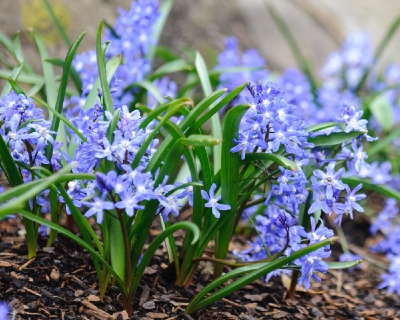10 award-winning (AGM) bulbs with blue flowers
Blue is one of the rarest flower colours in nature, making it all the more special in the garden. These easy, reliable bulbs bring uplifting colour to beds, borders and containers when it’s needed most
Making a lovely contrast to the many yellows and whites of early spring, small blue
They’re all easy to grow and many of them spread well. They are also all winners of the RHS Award of Garden Merit (AGM), meaning they’re tried and tested varieties that are widely available too. Planted in pots, troughs or in beds beneath bare-branched trees, these bulbs bring welcome bursts of colour just as the garden begins to wake up.
Perhaps the most popular of all scillas, Scilla siberica has mid-green foliage and deep violet blue, bell-shaped flowers up to 4cm (1½in) wide, making a winning combination. With up to five flowers hanging elegantly from the one-sided flower head, it’s delightful with white or pink hellebores and is happy almost anywhere that is not too hot and dry in summer. Height 8.5cm (3½in). Hardiness rating H6.
Scilla mischtschenkoana is one of the best of all early bulbs. It starts flowering around mid-January and lasts as long as two months. Unusually, the first flowers open as soon as it appears above ground and then more flowers open as the stem stretches. Each starry 2.5cm (1in) flower is ice-blue with a darker stripe through each petal. Best in partial shade. Height 15cm (6in). Hardiness rating H6.
Muscari aucheri ‘Ocean Magic’ is a compact, clump-forming bulbous perennial. In spring, it produces dense spikes of small, urn-shaped flowers that open from pale green
Flowering in February and early March, the alpine squill (Scilla bifolia) has lovely pink-tinted buds. These open to rich violet-blue or bright blue, star-shaped flowers. There are usually three to five, or sometimes as many as 10 flowers on each stem. Best in humus-rich soil in partial shade where it spreads steadily. It dislikes harsh summer drought. Height 10cm (4in). Hardiness rating H6.
A charming clump-forming
Scilla luciliae (Boiss.) Speta, (formerly Chionodoxa) is one of the largest flowered of the scillas, with flowers that measure 3.5cm (1¼in) across. Although there are usually only two or three flowers on each stem, they create quite an impact as the flowers face upwards and are relatively large. Each flattish, pale-blue flower has lavender overtones and shades to white in the centre. Flowers in April, best in partial shade. Height 10cm (4in). Hardiness rating H6.
Anemone apennina is a low-growing, rhizomatous perennial. Its delicate, finely divided leaves form a soft backdrop to solitary, daisy-like flowers that appear in early spring. Each bloom reaches up to 3.5cm (1.3in) wide and features 10 to 15 narrow, sky-blue petals held above a whorl of small stem leaves. This graceful plant is ideal for naturalising in woodland settings or shaded borders. Height 20cm (7.9in). Hardiness rating H6.
Scilla sardensis (formerly Chionodoxa) is genuinely blue in colour with relatively long, arching stems. Each 2.5cm (1in) flower is more or less bell-shaped and tends to face outwards rather than upwards. Best in partial shade. Height 12.5cm (5in). Hardiness rating H6.
Muscari latifolium is an unusual grape hyacinth, with a delightful two-tone flower head. At the top is a rather open cluster of about a dozen pretty, pale blue, sterile flowers. Lower down are about three times as many fertile flowers in purple turning to smoky-black at the tips. Self sows in sun or partial shade when happy, but is not so keen on hot dry summers. Height 15cm (6in). Hardiness rating H6.
Muscari ‘Jenny Robinson’ is a paler selection, flowering through April. The fragrant flowerhead is packed with up to 90 urn-shaped pale blue flowers opening from greenish buds. Originally called ‘Baby’s Breath’, it now commemorates Jenny Robinson who found the plant on Cyprus around 1970. Happy in the open or in partial shade. Height 20cm (8in). Hardiness rating H5.


